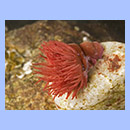- Norwegian: anemoner
Characteristics:
The order of sea anemones, Actiniaria, includes many colorful species, some of them resembling the anemone, a terrestrial flower. Although there are a few pelagic species, the majority of sea anemones are polyps attached to some surface by an adhesive foot. The cylinder-shaped body ends in an oral disk, surrounded by tentacles. The tentacles are armed with stinging cells used to paralyze their prey. Like other members of the subclass Hexacorallia, they have a sixfold symmetry. The number of tentacles, for instance, is usually dividable by six.
Unlike many other cnidarians, the sea anemones lack the medusa phase in their life cycle. Eggs are fertilized by sperm and produce larvae. These attach to some surface to develop a new polyp. Additionally, many anemones are capable of asexual reproduction by budding - small pieces of the foot develop to new polyp, genetically identical with the offspring.
Taxonomy:
Actiniaria is one of six orders in the Hexacorallia subclass. There are more than 1000 registered species, organized in four suborders. The two suborders Nynantheae and Protantheae include most of the common sea anemones along the North-European coastlines.














